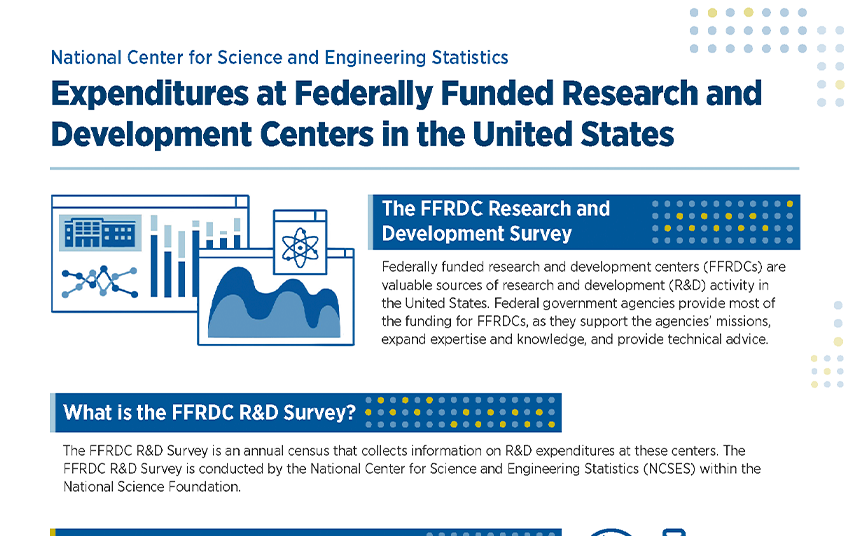Sampling error. Because the FY 2022 survey was a survey distributed to all organizations in the universe, there was no sampling error.
Coverage error. Given the availability of a comprehensive FFRDC list, there is no known coverage error for this survey. FFRDCs are identified through the NSF Master Government List of FFRDCs. NSF is responsible for maintaining the master list and queries all federal agencies annually to determine changes to, additions to, or deletions from the list.
Nonresponse error. Most FFRDCs have incorporated the data needed to complete most of the survey questions into their record-keeping systems. Eleven FFRDCs chose not to complete any of Question 4 (R&D costs), which asks for expenditures by type of cost. Ten of those FFRDCs are managed by private companies for whom salary information is considered proprietary. One FFRDC, which is managed by a university, does not capture direct and indirect costs in their financial system in a way that is reportable on Question 4. Other FFRDCs did not answer all sections of Question 4: two FFRDCs could not provide information on software and equipment expenditures, and one could not provide data on equipment expenditures. One FFRDC did not report its operating budget (Question 5). Eight FFRDCs chose not to complete Question 6, which asks for full-time equivalents and headcounts for R&D staff. Six of those FFRDCs are managed by private companies for whom staffing structure information is considered proprietary. Variables for Questions 4, 5, and 6 are not tabulated and are not included in the public use file.
Measurement error. NCSES discovered during the FY 2011 survey cycle that seven FFRDCs were including capital project expenditures in the R&D totals reported on the survey. Corrections made for the FY 2011 survey cycle lowered total expenditures by $468 million. However, previous years still include an unknown amount of capital expenditures in the total. The amount is estimated to be less than $500 million per year.
Prior to the FY 2011 survey, the five FFRDCs administered by the MITRE Corporation had reported only internally funded R&D expenditures. After discussions with NCSES, these five FFRDCs agreed to report all FY 2011 operating expenditures for R&D and to revise their data for FYs 2008–10.
NCSES discovered during the FY 2013 survey cycle that Los Alamos National Laboratory (LANL) was reporting some expenditures that were not for R&D, as defined by this survey. Corrections made for the FY 2013 survey cycle lowered the laboratory’s total expenditures by $349 million. LANL also was incorrectly reporting that all expenditures were for basic research. In corrections made for FY 2013, LANL reported that $1,554 million (91%) of its total research expenditures was for applied research. LANL data from previous years still include an unknown amount of expenditures that were not for R&D and categorize all expenditures as basic research.
Prior to FY 2014, the Aerospace FFRDC reported only expenditures on internal R&D projects. After discussions with NCSES, the Aerospace Corporation agreed to report all R&D expenditures for FY 2014 and provide revised data to include all R&D expenditures for FYs 2010–13. R&D expenditures increased by more than $800 million each year.
Prior to the FY 2021 collection, NCSES discovered that the Green Bank Observatory had split from the National Radio Astronomy Observatory on 1 October 2016, both retained FFRDC status. For FY 2017–20, R&D expenditures reported for the National Radio Astronomy Observatory, include the expenditures for the Green Bank Observatory. The Green Bank Observatory began reporting separately on the FY 2021 survey.
NCSES discovered during the FY 2022 survey cycle that two FFRDCs, Idaho National Laboratory and Savannah River National Laboratory, were incorrectly classified as industry-administered FFRDCs for select years. Idaho National Laboratory’s industrial firm administrator, Bechtel BWXT Idaho, LLC, was replaced by a nonprofit administrator, Battelle Energy Alliance, LLC, in February 2005. The classification was corrected for FY 2022 and Idaho National Laboratory’s FYs 2005–21 data were reclassified as coming from a nonprofit-administered FFRDC. Savannah River National Laboratory’s industrial firm administrator, Savannah River Nuclear Solutions, LLC, was replaced by a nonprofit administrator, Battelle Savannah River Alliance, LLC, in December 2020. The classification was corrected for FY 2022 and Savannah River National Laboratory’s FY 2021 data were reclassified as coming from a nonprofit-administered FFRDC.
 An official website of the United States government
An official website of the United States government


